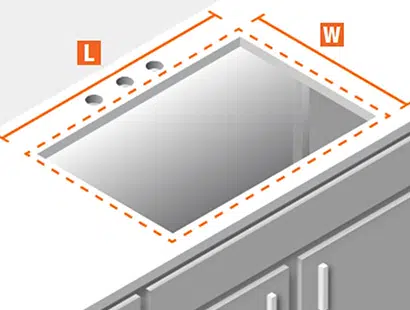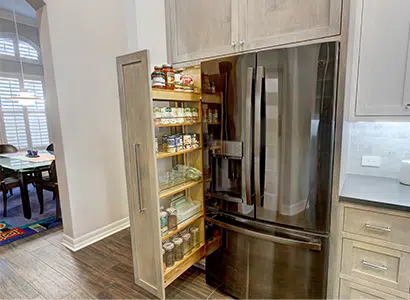Introduction
Choosing the right cabinet material will impact the appearance, lasts, and works. No matter whether you’re going to remodel your kitchen or build a new kitchen, it’s necessary to know kitchen cabinet material before starting your project.
This guide will not only talk about core materials but also share finishing materials to help you make a smart choice in kitchen cabinets.
Types of Kitchen Cabinet Core Material
Core material is a type of material used to create the cabinet door and framework, it builds the main structure for cabinets.
Solid Wood

Solid wood is cut from a tree without any engineered or layered and mixed process; it preserves the texture of the trees themselves, and it can offer you natural beauty for your kitchen cabinets. But they’re the most expensive option among the materials and require frequent maintenance.
Pros:
- Durable: It’s very strong and can last for no less than 30 years if it is cared for properly.
- Can Be Refinished: Even if it looks older or out of style, you can sand it and paint or stain it again to have a new look.
- Natural Appearance: They offer natural wooden grain and texture, which can give your kitchen a high-end appearance.
- Eco-Friendly: They do not release any harmful, irritating odors or formaldehyde, green materials for your life.
- Improve Kitchen Value: If you want to resell your house, a solid wood kitchen cabinet can improve your resale value.
Cons:
- Expensive: Solid Wood is more expensive than other engineered wood.
- Warp or Crack Problems: If not maintained well, you will suffer warp or crack problem.
- Too Heavy: The heavier the more stable, but it will also make shipping more expensive, for upper cabinets, it will be hard to install.
Maintenance Tips:
Wipe with a mild, wood-specific cleaner; avoid prolonged water exposure.
Popular Types of Solid Wood
Red Oak: Red oak offers open grain with a reddish tint, and affordable; it’s a good material for kitchen cabinets.
White Oak: White oak offers smooth and fine grain for kitchen cabinets; it is often used to pair with black countertops to create a modern look.
Hard Maple: Hard maple has a light color and a smooth and pale surface; it’s often used for painted cabinets.
Hickory: Hickory shows pale yellow and has lots of grain contrast. People often use it to create rustic and farmhouse-style kitchen cabinets.
Plywood

Plywood is a type of engineered wood made from multiple thin layers of real wood that are glued together. Plywood is often used to create a cabinet frame, as it offers a durable structure.
Pros:
- Stable: Plywood is less prone to warp or crack than solid wood
- Cost-Effective: Plywood is an affordable option compared with solid wood.
Cons:
- Exposed Edges: Edges should be banded to have a finished look.
- Quality Varies: There are different quality grades of plywood in the market, which can make it hard to identify.
Maintenance Tips: Wipe with a damp cloth; seal exposed edges to prevent moisture ingress.
Medium Density Fiberboard (MDF)

MDF is a type of cost-effective engineered wood. It’s made from wood fibers bonded with wax or resin under high heat and pressure. Features a smooth surface, ideal for use on cabinet doors or as a finish substrate.
Pros:
- Smooth Surface: MDF has a smooth surface, which is ideal for painting and veneering, with no grain lines.
- Cost-Effective: MDF is cheaper than plywood and solid wood; it’s a good material for hotel, apartment that and of building projects.
Cons:
- Poor Moisture Resistance: Unless sealed, it’s easy to suffer swelling and get damaged when wet.
- Heavier than Plywood: It’s heavier than plywood, making shipping and installation be more difficult.
- Not Strong: It can not be used for heavy loads, otherwise, it can sag.
- Can’t Hold Screws Over Twice: Fibers can crumble or split apart under excessive force or tightening the screws more than twice.
High-Density Fiberboard (HDF)

HDF is similar to MDF but pressed at a higher pressure for greater density, hardness, and strength, which is also called hardboard.
Pros
- Strong: HDF is stronger and harder than MDF due to the higher pressure used.
- Durable: This material can resist dents better than MDF and doesn’t warp easily, offering you a stable structure.
Cons
- Poor Moisture Resistance: Same with MDF, it will swell if exposed to water.
- Expensive: Compared with MDF, it’s more expensive
- Heavy Weight: Due to its being made under higher pressure, the weight is heavier than MDF and particleboard, and can be hard to handle.
Particle Board

Particleboard is another type of engineered wood. It is made from wood chips, wood shavings, and sawdust, all held together by resin. It is the least expensive core material.
Pros: Least expensive material, lightweight.
Cons: Low strength, does not hold screws well over time, susceptible to moisture damage.
Care Requirements: Must be kept very dry. Once particleboard gets wet and swells, it is ruined beyond being able to be fixed.
Bamboo

Bamboo is actually a grass, not a wood. The grass is manufactured and made into sheets or boards that can be used for cabinet installations.
Pros: Sturdy and durable, unique and contemporary style, has a sustainable source.
Cons: Sometimes more expensive than some hardwoods, and the quality can vary widely.
Care Requirements: Clean using a mild pH neutral cleaner. Use caution with harsh chemicals which will damage the finish.
Kitchen Cabinet Surface Material Types
The surface material is a finish that is made for application over the core. It protects the cabinet and final color/ texture.
Thermofoil

Thermofoil is a thin layer of vinyl. It is heated and vacuum pressed onto a core material, typically, MDF. This process creates a smooth, seamless surface. Thermofoil is most often used for high gloss finish cabinets.
Pros: Easy to clean, multiple colors and sheens, inexpensive.
Cons: Can peel or delaminate when exposed to high heat, difficult to repair if scratched or chipped.
Care requirements: Non-abrasive cleaners. Be careful with hot items placed under the cabinets, such as toasters or coffee makers.
Laminate

Laminate is a robust product made of layers of paper and plastic resins fused together. Those layers are glued to core products such as MDF or particleboard. There are lots of durable laminate options for kitchen cabinets.
Pros: Very durable, scratch and stain resistant, many different colors and patterns available.
Cons: Can chip on a stronger impact, not easy to hide any repairs.
Care needs: Wipes clean easily with a damp cloth and mild detergent.
Melamine

Melamine is a type of laminate where paper soaked in resin is fused directly onto the core using heat and pressure, with particleboard as the core product. A Melamine kitchen cabinet is very popular and affordable.
Pros: Very inexpensive, durable, very consistent, and uniform color.
Cons: Can chip; if water penetrates the melamine layer, the particleboard underneath can get damaged.
Care Needs: Easy to clean with any standard household cleaner, and check edges and corners for damage to the seal.
Wood Veneers

A wood veneer is a very thin slice of hardwood. That thin layer is glued onto a stable core such as plywood or MDF.
Pros: Provides the authentic look of actual wood for much less money, is more stable than solid wood, and is less likely to warp.
Cons: Like laminate, it can be chipped and scratched, but can typically only be sanded lightly or not at all.
Care needs: Treat it as real wood; cleaners and polish used must be wood-safe in order to maintain appearance.
Polyester

A polyester finish entails the use of a layer of paper, with a polyester film, applied on an MDF core. It is more durable than melamine.
Advantages: Extremely scratch and wear resistant; has a more consistent and attractive surface finish than melamine.
Disadvantages: More expensive than melamine and laminate materials, and there are fewer options for repairs.
Care Requirements: Almost no upkeep. It can be wiped down with a damp rag and mild cleaner.
How To Decide On Cabinet Materials
When deciding, you want to consider two factors:
1. Your budget comes first. Materials will range from very, to expensive.
- The Least Expensive: Particle Board with a melamine finish
- The Middle: MDF with a thermofoil or painted finish; Plywood with a laminate finish
- The Most Expensive: Solid hardwood or hardwood veneer on high-quality plywood.
2. Customization Consider your style options.
- If you want to achieve a smooth, flawless painted look (like many shaker-style cabinets), then MDF is ideal.
- If you want to see wood grain through a stain, you have to use solid hardwood or wood veneer.
- If you want bold, solid colours, laminate and thermofoil offer more variety for you to explore. You can get creative with alternatives and unique looks like these green kitchen cabinet examples.
Conclusion
Selecting the right cabinet material has to do with locating the right balance of cost, styling, and strength for your space. As you are aware, the difference between a strong core like plywood, and a gorgeous surface like wood veneer will help you make a decision you will have confidence in for many years to come.
If you are looking for more options and total customization, look for a supplier that has a full-service supplier like AJ Flying.
FAQs
1. What is the best material to make kitchen cabinets out of?
Plywood is typically the best all-around material – it is often very strong, holds screws well, and generally has better moisture and warp resistance than solid wood or even particle board.
2. Is MDF good enough for a kitchen?
Yes, MDF works well for kitchen cabinets, especially doors, because it is perfectly smooth and is a perfect base for a high-end paint finish. You just need to make sure the MDF is sealed properly, either with paint or a surface finish to protect it from water.
3. What is the cheapest material for kitchen cabinets?
The cheapest material is particle board with a melamine or laminate finish – this is what you will find in many budget ready-to-assemble kitchen cabinets. You should be able to achieve a clean look for a very minimal price.
4. What is the most durable finish for kitchen cabinets?
High-pressure laminate (HPL) and polyester are usually the most durable finishes. They stand up fairly well to most scratches and stains, and resist heat reasonably well, which is really useful if you do a lot of cooking in your kitchen.



